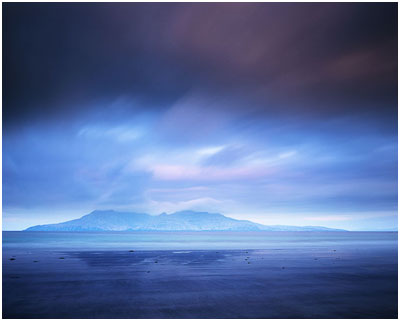In 2008 I wrote an article on this blog regarding how to place ND grads on a rangefinder camera. I've since then had the occasional email from someone about how to correctly place them and I'd like to add some additional things to my original posting about this issue. I'd firstly like to start by saying that I like mistakes in my photography. I like the surprise element so I'm not too bothered whether the grad placement is exact. If I like the results, and they're pleasing to me, then that's all that I'm bothered about.
Here are a few examples of images where I really got the grad placement really wrong, and yet the images (in my opinion - which is really all that matters) are a success because of the wrong placement:
I was aware when shooting the Calanish standing stones, that placing the grad half way across them would cause the top parts of the stones to be black and the bottom parts to be correctly exposed. I wanted to make sure the sky was the same luminance as the ground so I placed the grad right above them and hoped for the best. The final image you see here has an almost halo like effect in the sky - this has been caused by the natural light fall-off that the lens exhibits being compounded by the grad. Yes, my Mamiya 7 lenses exhibit light fall-off. It is quite pronounced in the wide angles and I love the effect very much. I really like this image and felt it worked very well because the top 1/3rd of the sky is similar in tone to the lower tones of the grass.
I think one of the biggest mistakes folks make when using grads is to assume they should always go over the horizon. They don't always have to be.
And with this image taken on the Isle of Eigg, I can't quite remember my justification for keeping the grad so high - perhaps I just forgot to adjust it when I'd changed composition (this is a common mistake for a lot of photographers - rangefinder or not). Anyway, I love the effect that the grad caused and I feel it's added a lot of mood to the shot. Now imagine if I'd placed the grad correctly - would the image be as dramatic? I don't think so.
But what if the grad is just slightly too high, just not quite right? Well, in the next image, I managed to place it in the wrong place:
I think my reasons for leaving the grad a little high above the horizon was that I was worried that I'd perhaps compress the tones in the Isle of Rum on the horizon - and therefore under-expose the island. So I opted for moving the grad slightly higher, but managed to move it just a bit too high. Does it kill the image? Well, it's a personal taste question, but for me, I prefer when grads are just slightly above the horizon, as I kind of expect horizons to be bright. It gives a sense of presence to an image, so in that way, I don't think the bright horizon is too much of an issue. But now that I've pointed out to you that the grad is in the wrong place - you'll probably feel the image has an issue. If that's true - it's your problem and not mine. I feel that I'm able to take a step further away from the image and just see it in its entirety. And when I look at it, like someone would who is viewing it for the first time - I don't notice the grad placement - there's simply far too much else of interest going on for me. So I think the lesson with this is to be able to not focus on something too much. Once you notice a problem, you tend to stare at it..... once you point out a problem, everyone notices it. But if you hadn't pointed it out, most folks I reckon, wouldn't see it. What others see and what you see are two very different things.
But I'm sure there are images where the grad placement is critical. I certainly get emails from folks who tell me the grad placement was very noticeable, and for that, I'd like to suggest that the reason it is so noticeable, is because they've used too strong a grad in the first place. The tell tale signs for too strong a grad are usually overly bright grounds and dark skies. Sure, it looks dramatic, but it also suffers from being extremely sensitive to where the grad is placed. So maybe this is a lesson in easing off the strength of grad you use, and learning to tell which lighting conditions and times of day will require a 1 stop rather than a 3 stop, or a 2 stop rather than a 3 stop.
Ultimately, I don't think grad placement is really the problem. If you use the right strength of grad, over a subject which doesn't have such a dramatic change in light levels, then a little bit of bad placement shouldn't really be a problem.
Lastly, If you still think grad placement is a real problem for you - then Lee Filters now have a Rangefinder ND grad set, with a special holder with markings on it, to aid in the correct placement of the filters. I'd give that a go, if my advice doesn't help you in any way.



